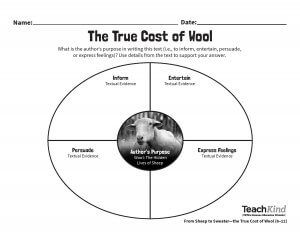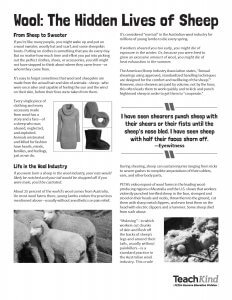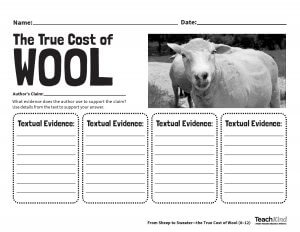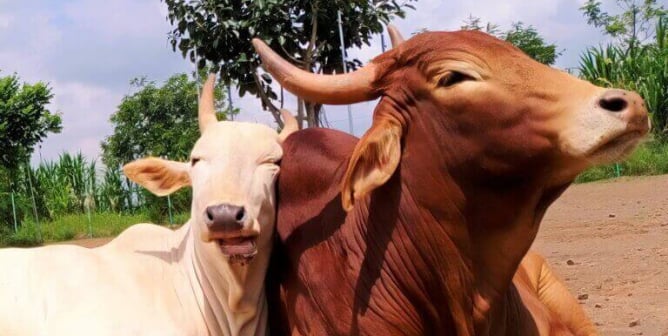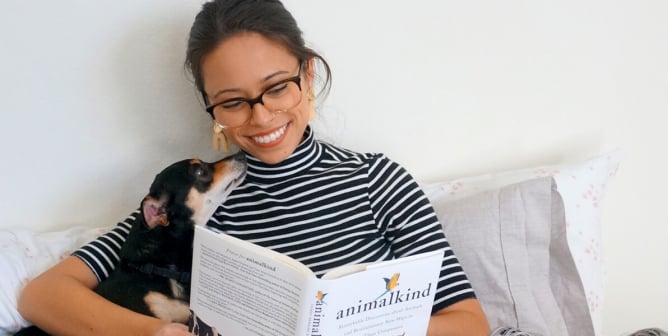From Sheep to Sweater—the True Cost of Wool (Grades 6–12, English and Spanish)
This lesson plan is designed to help teachers present animal rights issues to their students. If you’re an educator, please feel free to adapt this material to fit your needs, and contact us if you need help incorporating this activity into your curriculum.
Spanish-language educators: This lesson plan is available here in Spanish.
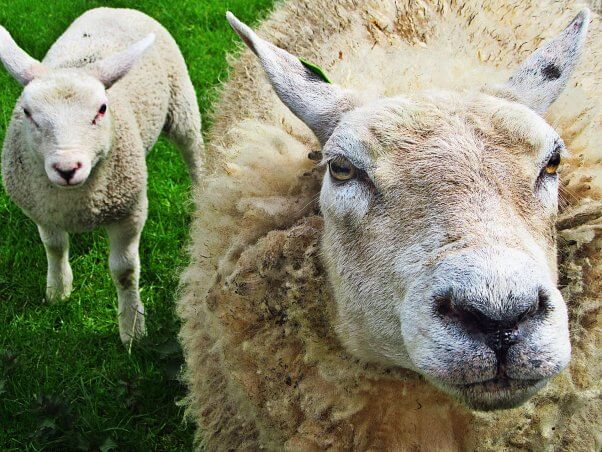
Suggested grade levels: 6–12
Objectives:
- Affective: Students will be able to demonstrate an understanding of the lives of sheep used for wool and to explain why it’s cruel to buy and wear wool.
- Cognitive: Students will be able to determine an author’s purpose in a text and analyze how he or she acknowledges and responds to conflicting viewpoints.
Background
Sheep are gentle individuals who, like all animals, have the capacity to experience pain, fear, and loneliness. But because there’s a market for their fleece and skin, the wool industry treats them as nothing more than wool-producing machines.
As in other industries in which animals are raised for profit, the interests of the animals used in the wool trade are rarely considered. Flocks usually consist of thousands of sheep, and individual attention to their needs is virtually impossible.
It’s important that we teach students to consider sheep as individuals and to understand the ethical cost of using wool in everyday items. We can help them avoid supporting the cruelty of the wool industry by making them aware of the many wool-free clothing options that are available.
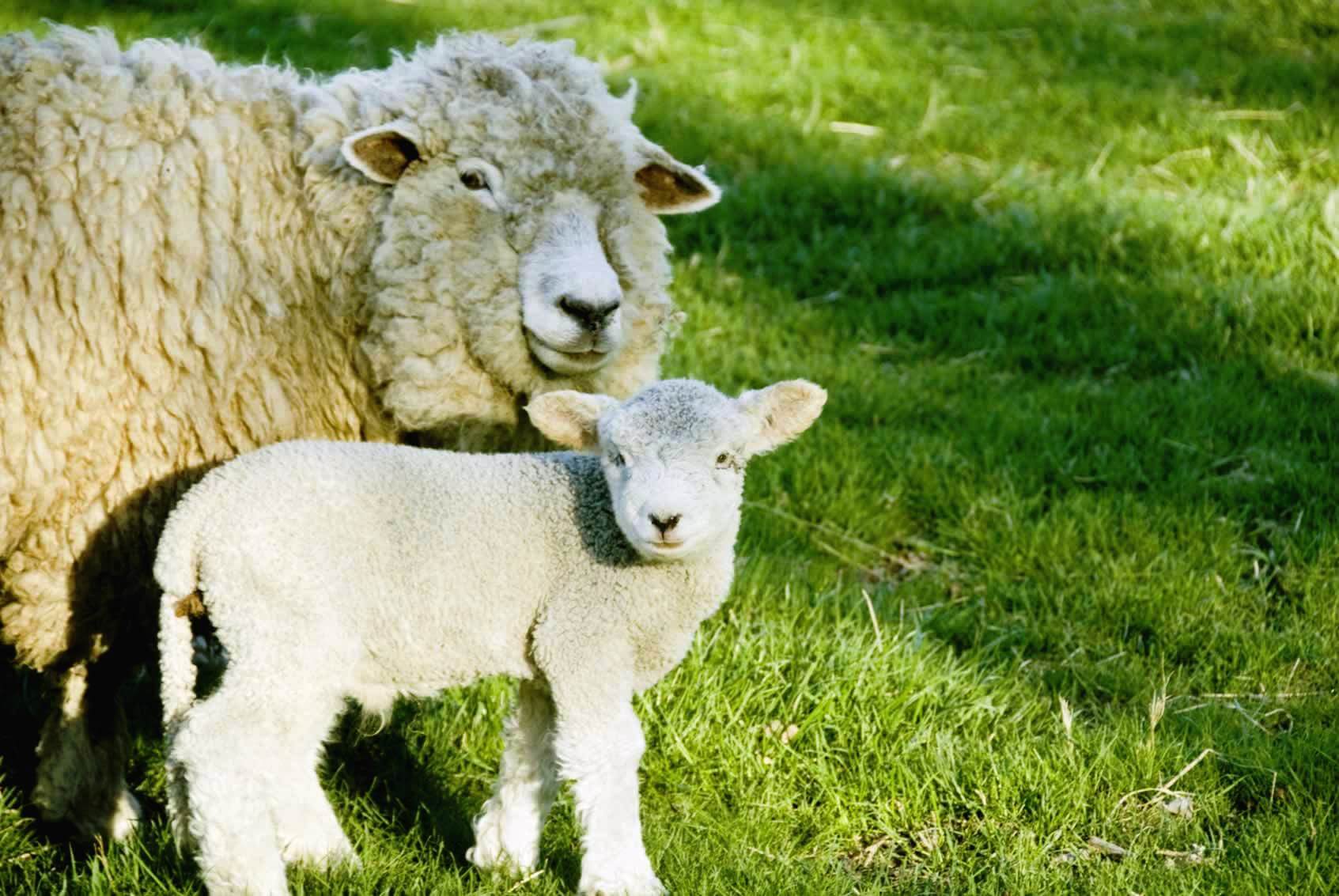
Materials
- Examples of an informational text and novel that you’ve already read with the students
- “Animal Kingdom” (song and lyrics) by Prince
- Author’s purpose graphic organizer
- “Wool: The Hidden Lives of Sheep” text
- Author’s claim graphic organizer
- Sweaters, scarves, hats, gloves, coats, or other items made from an animal-free fabric
Resources
Key Vocabulary
- shear: to cut the wool off a sheep or other animal
- auction: a public sale in which goods or property are sold to the highest bidder
Motivation
The image below is an advertisement for a social issue campaign. Begin the lesson by showing it to the students and asking them to explain what they think it’s referring to. How do they feel when they look at it? Why? Have them share their responses.
Before Reading
Tell students that every author has a purpose or reason for writing in a particular way. Hold up an informational text that you’ve read together. Explain that some authors write to inform (i.e., give readers facts about a topic), just as the author of your example text did.
Next, hold up a novel that you’ve read together. Explain that some authors write to entertain—just as this author did—then, briefly describe the story. Tell the students that novels help readers escape into fictional worlds and may also inform them about something at the same time. For example, a story set during a certain period in history, such as the Revolutionary War, may offer them facts and information about that time. After this explanation, create an author’s purpose anchor chart (to inform, to entertain).
Explain that authors often have more than one reason for writing. Read Shel Silverstein’s short poem “Point of View”. Inform the students that in this case, the author writes to express his feelings about animals used for food as well as to entertain. Record “to express his/her feelings” on the anchor chart.
Now, model how to use the author’s purpose graphic organizer using textual details to identify the author’s purpose for writing.
Play “Animal Kingdom” by Prince and show students the song lyrics. Ask them the following questions:
- How does the songwriter feel about animals? (He doesn’t think that they should be harmed.)
- What details tell you this? (“No member of the animal kingdom ever did a thing 2 me”)
- Why do you think the author wrote these song lyrics? (He wanted to express his belief that animals have the right to live their own lives in peace, just as humans do.)
- How can you tell? (“We’re all members of the animal kingdom”)
- What other reason might he have had for writing these song lyrics? (He wanted to persuade people to stop eating animals.)
- How do you know? (“Leave your brothers and sisters in the sea”)
Model how to add these details to the author’s purpose graphic organizer and record “to persuade the listener to take some kind of action” on the anchor chart.
During Reading
Explain that today, the students will analyze a text in order to determine the author’s purpose. Invite them to get into groups of three or four. Distribute printed copies of the author’s purpose graphic organizer. Have students read the section titled “From Sheep to Sweater” from “Wool: Hidden Lives of Sheep”.
Students should then work with their group to add the author’s purpose to the graphic organizer. They must indicate the writer’s purpose along with textual evidence (i.e., words or phrases from the text that support their interpretation).
Have them read the rest of the “Wool: The Hidden Lives of Sheep” text and complete the author’s purpose graphic organizer with their group. Discuss their responses as a class.
Next, distribute printed copies of the author’s claim graphic organizer.
Have students work in their groups to complete them. Ask them the following questions to prompt discussion and critical thinking:
- What claim is the author making?
- What evidence is presented to support the claim? Provide three details from the text.
Then, discuss the following questions as a class:
- What is a conflicting viewpoint? (A conflicting viewpoint goes against what the author believes.)
- What conflicting viewpoint has the author presented? (The author has mentioned the American Sheep Industry Association’s claim that shearing is necessary and done for the well-being of the sheep.)
- Why did the author include this? (It provides the author with something to argue against and helps readers understand what the other point of view is and why they shouldn’t believe or trust it.)
- How has the author responded to the conflicting viewpoint? (The author has responded by presenting evidence that proves that the conflicting viewpoint is untrue: “However, since shearers are paid by volume, not by the hour, this often leads them to work quickly and to kick and punch frightened sheep in order to get them to ‘cooperate,’” and “If they were left alone and not genetically manipulated, they’d grow just enough wool to protect themselves from temperature extremes. The fleece provides them with effective insulation against both cold and heat. But in the wool industry, farmers have bred them to grow an unnatural amount of wool by forcing individuals with thick fleeces to mate.”)
After Reading
Have students get into cooperative learning groups, in which each participant is given one of the following roles to play: a sheep farmer, an American Sheep Industry Association representative, an animal rights activist, and a sheep. Ask them to debate the question “Should sheep be farmed for their wool?” from the perspective of their respective roles. They’ll present their position (claim) and supporting arguments (evidence) to the class or in a written assignment. Note: Students will need to do additional research for this portion of the activity.
Real World Connection
Tell the students that many items that they see and even use on a daily basis may be made from skin and hair cruelly obtained from animals—including sheep. For example, UGG boots are made from sheep’s skin. Show the class vegan boots and wool-free garments available online, discuss what the items are made from, and tell them that these can keep people just as warm as wool can. Then, let them touch and try on the wool-free items that you’ve brought in. Stress that there’s no reason for people to purchase wool, since there are plenty of cruelty-free options available. Explain that sheep are abused on farms every day, because humans buy wool items and see the sheep only as the source of hats, scarves, gloves, coats, or boots (i.e., as objects or things), not as living, feeling beings.
Afterward, stream the “If Barbers Acted Like Sheep Shearers and Farmers” video.
Ask the students, “How would you feel if you were treated like a sheep in the wool industry?” Have them respond by creating a tweet-style message in 140 characters or fewer.
Wrap-Up
Ask the students to share their tweets and any important information that they learned during the cooperative group work. Discuss why it’s important that people learn more about where wool comes from and explore what students can do to help sheep (e.g., choosing not to buy wool items). As a group, turn the information that they’ve acquired into a hashtag that people can use to help raise awareness of this issue on social media (e.g., #UGGsAreUgly). Write the hashtag on the whiteboard, and encourage students to use it when sharing what they’ve learned on their social media accounts.
Assessment
Evaluate students’ written responses on the author’s purpose and claim graphic organizers as well as their tweets about what they can do to help sheep.
Common Misperception
Some people think that wool comes from sheep who are just “getting a haircut.”
Reality
If sheep were left alone and not genetically manipulated, they’d grow just enough wool to protect themselves from temperature extremes. Their fleece provides them with effective insulation against both cold and heat. But in the wool industry, farmers have bred them to grow an unnatural amount of wool by forcing individuals with thick fleeces to mate.
Extension
Get students more involved in helping animals used for their wool, fur, or skin. Take further action on this issue as a class by asking them to tell the CEO of Deckers Brands, which owns UGG, to replace real sheepskin with vegan materials.
Common Core Standards Addressed
RI.6–12.6: Determine an author’s point of view or purpose in a text.
SL.6–12.1: Initiate and/or participate effectively in a range of collaborative discussions.
Additional Information
- The Hidden Lives of Sheep
- What’s Wrong With UGGs? (teen-friendly)
Common Core Standards: © Copyright 2010. National Governors Association Center for Best Practices and Council of Chief State School Officers. All rights reserved.


